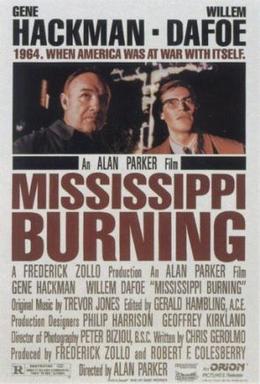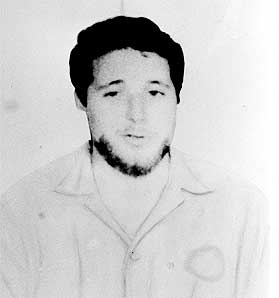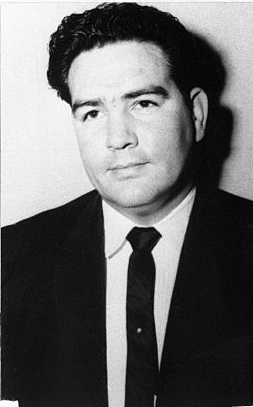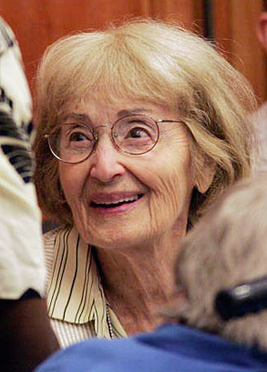
Andrew Goodman was an American civil rights activist. He was one of three Congress of Racial Equality (CORE) workers murdered in Philadelphia, Mississippi, by members of the Ku Klux Klan in 1964. Goodman and two fellow activists, James Chaney and Michael Schwerner, were volunteers for the Freedom Summer campaign that sought to register African-Americans to vote in Mississippi and to set up Freedom Schools for black Southerners.

Mississippi Burning is a 1988 American crime thriller film directed by Alan Parker that is loosely based on the 1964 murder investigation of Chaney, Goodman, and Schwerner in Mississippi. It stars Gene Hackman and Willem Dafoe as two FBI agents investigating the disappearance of three civil rights workers in fictional Jessup County, Mississippi, who are met with hostility by the town's residents, local police, and the Ku Klux Klan.

Michael Henry Schwerner was an American civil rights activist. He was one of three Congress of Racial Equality (CORE) field workers killed in rural Neshoba County, Mississippi, by members of the Ku Klux Klan. Schwerner and two co-workers, James Chaney and Andrew Goodman, were killed in response to their civil rights work, which included promoting voting registration among African Americans, most of whom had been disenfranchised in the state since 1890.

Freedom Summer, also known as the Freedom Summer Project or the Mississippi Summer Project, was a volunteer campaign in the United States launched in June 1964 to attempt to register as many African-American voters as possible in Mississippi. Blacks had been restricted from voting since the turn of the century due to barriers to voter registration and other laws. The project also set up dozens of Freedom Schools, Freedom Houses, and community centers such as libraries, in small towns throughout Mississippi to aid the local Black population.

James Earl Chaney was an American civil rights activist. He was one of three Congress of Racial Equality (CORE) civil rights workers killed in Philadelphia, Mississippi, by members of the Ku Klux Klan on June 21, 1964. The others were Andrew Goodman and Michael Schwerner from New York City.

The murders of Chaney, Goodman, and Schwerner, also known as the Freedom Summer murders, the Mississippi civil rights workers' murders, or the Mississippi Burning murders, were the abductions and murders of three activists in Philadelphia, Mississippi, in June 1964, during the Civil Rights Movement. The victims were James Chaney from Meridian, Mississippi, and Andrew Goodman and Michael Schwerner from New York City. All three were associated with the Council of Federated Organizations (COFO) and its member organization, the Congress of Racial Equality (CORE). They had been working with the Freedom Summer campaign by attempting to register African Americans in Mississippi to vote. Since 1890 and through the turn of the century, Southern states had systematically disenfranchised most black voters by discrimination in voter registration and voting.

Alton Wayne Roberts was an American murderer and white supremacist. Roberts, a member of the White Knights of the Ku Klux Klan, was convicted for his role in the 1964 Freedom Summer murders. He was the one who fatally shot two of the victims, Congress of Racial Equality civil rights activists Michael Schwerner and Andrew Goodman. Roberts also shot the third activist, James Chaney, but it is debated by some that it was another accomplice, James Jordan, who had killed him. Jordan had identified Roberts as Chaney's killer. In 1967, he was charged and convicted of depriving the slain activists of their civil rights.

Cecil Ray Price was an American police officer and white supremacist. He was a participant in the murders of Chaney, Goodman, and Schwerner in 1964. At the time of the murders, Price was 26 years old and a deputy sheriff in Neshoba County, Mississippi. He was a member of the White Knights of the Ku Klux Klan.

Murder in Mississippi is a 1990 television film which dramatized the last weeks of civil rights activists Michael "Mickey" Schwerner, Andrew Goodman and James Chaney, and the events leading up to their disappearance and subsequent murder during Freedom Summer in 1964. It starred Tom Hulce as Schwerner, Jennifer Grey as his wife Rita, Blair Underwood as Chaney, and Josh Charles as Goodman. Hulce received a nomination for Best Actor in a TV Miniseries at the 1990 Golden Globes.
Jerry W. Mitchell is an American investigative reporter formerly with The Clarion-Ledger, a newspaper in Jackson, Mississippi. He convinced authorities to reopen cold murder cases from the civil rights era, prompting one colleague to call him "the South's Simon Wiesenthal". In 2009, he received a "genius grant" from the MacArthur Foundation.
Mississippi Cold Case is a 2007 feature documentary produced by David Ridgen of the Canadian Broadcasting Corporation about the Ku Klux Klan murders of two 19-year-old black men, Henry Hezekiah Dee and Charles Eddie Moore, in Southwest Mississippi in May 1964 during the Civil Rights Movement and Freedom Summer. It also explores the 21st-century quest for justice by the brother of Moore. The documentary won numerous awards as a documentary and for its investigative journalism.

The White Knights of the Ku Klux Klan is a Ku Klux Klan organization which is active in the United States. It originated in Mississippi and Louisiana in the early 1960s under the leadership of Samuel Bowers, its first Imperial Wizard. The White Knights of Mississippi were formed in December 1963, when they separated from the Original Knights after the resignation of Imperial Wizard Roy Davis. Roughly 200 members of the Original Knights of Louisiana also joined the White Knights. The White Knights were not interested in holding public demonstrations nor were they interested in letting any information about themselves get out to the masses. Similar to the United Klans of America (UKA), the White Knights of Mississippi were very secretive about their group. Within a year, their membership was up to around six thousand, and they had Klaverns in over half of the counties in Mississippi. By 1967, the number of active members had shrunk to around four hundred.

Fannie Lee Chaney was an American baker turned civil rights activist after her son James Chaney was murdered by the Ku Klux Klan during the 1964 Freedom Summer rides in Mississippi.

Carolyn Elizabeth Goodman was an American clinical psychologist who became a prominent civil rights advocate after her son, Andrew Goodman and two other civil rights workers, James Chaney and Michael Schwerner, were murdered by the Ku Klux Klan in Neshoba County, Mississippi, in 1964.

George Raymond Jr. was an African-American civil rights activist, a member of the Mississippi Freedom Democratic Party, a Freedom Rider, and head of the Congress of Racial Equality in Mississippi in the 1960s. Raymond influenced many of Mississippi's most known activists, such as Anne Moody, C. O. Chinn, and Annie Devine to join the movement and was influential in many of Mississippi's most notable Civil Rights activities such as a Woolworth's lunchcounter sit-in and protests in Jackson, Mississippi, Meredith Mississippi March, and Freedom Summer. Raymond fought for voting rights and equality for African Americans within society amongst other things.

The Problem We All Live With is a 1964 painting by Norman Rockwell that is considered an iconic image of the Civil Rights Movement in the United States. It depicts Ruby Bridges, a six-year-old African-American girl, on her way to William Frantz Elementary School, an all-white public school, on November 14, 1960, during the New Orleans school desegregation crisis. Because of threats of violence against her, she is escorted by four deputy U.S. marshals; the painting is framed so that the marshals' heads are cropped at the shoulders. On the wall behind her are written the racial slur "nigger" and the letters "KKK"; a smashed and splattered tomato thrown against the wall is also visible. The white protesters are not visible, as the viewer is looking at the scene from their point of view. The painting is oil on canvas and measures 36 inches (91 cm) high by 58 inches (150 cm) wide.
The history of the 1954 to 1968 American civil rights movement has been depicted and documented in film, song, theater, television, and the visual arts. These presentations add to and maintain cultural awareness and understanding of the goals, tactics, and accomplishments of the people who organized and participated in this nonviolent movement.
Rita Levant SchwernerBender is an American civil rights activist and lawyer. She and her first husband Michael (Mickey) Schwerner participated in the Freedom Summer of 1964, where Michael was murdered by the Ku Klux Klan. As his young widow, she drew national attention for her commentary on racial prejudice in the United States, delivered at a press conference after her husband went missing. After the Civil Rights Movement, Schwerner became an attorney, practicing family law in Washington state. She continues to advocate for civil rights through her law practice and public presentations.
"Here's to the State of Mississippi" is a civil rights protest song by Phil Ochs, an American topical singer and songwriter in the 1960s. Ochs is best known for his anti-war and freedom songs. "Here's to the State of Mississippi" was released in 1965 as the last track on his album I Ain't Marching Anymore. The song criticizes the state of Mississippi for its oppression of African Americans. It describes how Jim Crow laws and white supremacy in the South maintained the inequality of African Americans in states such as Mississippi. "Here's to the State of Mississippi" touches on segregation, corrupt and biased school systems, the frequent murders of African Americans and civil rights activists and the crookedness of government officials who ignored or collaborated in the murders.

We Are Not Afraid: The Story of Goodman, Schwerner, and Chaney and the Civil Rights Campaign for Mississippi is a 1989 non-fiction book by Seth Cagin and Philip Dray. It concerns the murders of Michael Schwerner, Andrew Goodman, and James Chaney.















